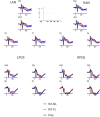Speak My Language and I Will Remember Your Face Better: An ERP Study
- PMID: 28539898
- PMCID: PMC5424200
- DOI: 10.3389/fpsyg.2017.00709
Speak My Language and I Will Remember Your Face Better: An ERP Study
Abstract
Here we investigated how the language in which a person addresses us, native or foreign, influences subsequent face recognition. In an old/new paradigm, we explored the behavioral and electrophysiological activity associated with face recognition memory. Participants were first presented with faces accompanied by voices speaking either in their native (NL) or foreign language (FL). Faces were then presented in isolation and participants decided whether the face was presented before (old) or not (new). The results revealed that participants were more accurate at remembering faces previously paired with their native as opposed to their FL. At the event-related potential (ERP) level, we obtained evidence that faces in the NL were differently encoded from those in the FL condition, potentially due to differences in processing demands. During recognition, the frontal old/new effect was present (with a difference in latency) regardless of the language with which a face was associated, while the parietal old/new effect appeared only for faces associated with the native language. These results suggest that the language of our social interactions has an impact on the memory processes underlying the recognition of individuals.
Keywords: face recognition; familiarity; foreign language; old/new ERP effects; recollection; social categorization.
Figures




Similar articles
-
Examining the neural basis of episodic memory: ERP evidence that faces are recollected differently from names.Neuropsychologia. 2009 Nov;47(13):2756-65. doi: 10.1016/j.neuropsychologia.2009.05.025. Epub 2009 Jun 6. Neuropsychologia. 2009. PMID: 19505485
-
Dissociating recollection from familiarity: electrophysiological evidence that familiarity for faces is associated with a posterior old/new effect.Neuroimage. 2007 Jun;36(2):454-63. doi: 10.1016/j.neuroimage.2006.12.005. Epub 2007 Apr 23. Neuroimage. 2007. PMID: 17451972
-
Recognition memory in developmental prosopagnosia: electrophysiological evidence for abnormal routes to face recognition.Front Hum Neurosci. 2014 Aug 14;8:622. doi: 10.3389/fnhum.2014.00622. eCollection 2014. Front Hum Neurosci. 2014. PMID: 25177283 Free PMC article.
-
Contextual effects of angry vocal expressions on the encoding and recognition of emotional faces: An event-related potential (ERP) study.Neuropsychologia. 2019 Sep;132:107147. doi: 10.1016/j.neuropsychologia.2019.107147. Epub 2019 Jul 17. Neuropsychologia. 2019. PMID: 31325481
-
Face recognition memory across the adult life span: event-related potential evidence from the own-age bias.Psychol Aging. 2012 Dec;27(4):1066-81. doi: 10.1037/a0029112. Epub 2012 Jun 25. Psychol Aging. 2012. PMID: 22731651
Cited by
-
Does Foreign-Accented Speech Affect Credibility? Evidence from the Illusory-Truth Paradigm.J Cogn. 2024 Feb 19;7(1):26. doi: 10.5334/joc.353. eCollection 2024. J Cogn. 2024. PMID: 38405636 Free PMC article.
-
Linguistic identity as a modulator of gaze cueing of attention.Sci Rep. 2023 Jul 4;13(1):10829. doi: 10.1038/s41598-023-37875-7. Sci Rep. 2023. PMID: 37402827 Free PMC article.
References
LinkOut - more resources
Full Text Sources
Other Literature Sources

